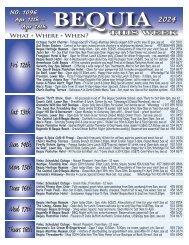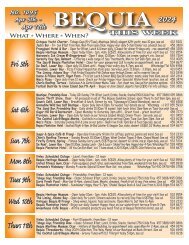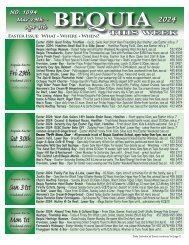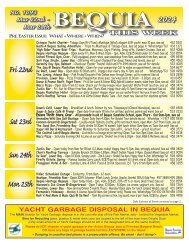Caribbean Compass Yachting Magazine - December 2021
Welcome to Caribbean Compass, the most widely-read boating publication in the Caribbean! THE MOST NEWS YOU CAN USE - feature articles on cruising destinations, regattas, environment, events...
Welcome to Caribbean Compass, the most widely-read boating publication in the Caribbean! THE MOST NEWS YOU CAN USE - feature articles on cruising destinations, regattas, environment, events...
You also want an ePaper? Increase the reach of your titles
YUMPU automatically turns print PDFs into web optimized ePapers that Google loves.
— Continued from previous page<br />
From Admiralty Bay, Bequia, to the south coast of<br />
St. Vincent is an interesting passage that few boats do<br />
correctly. The channel between Bequia and St. Vincent<br />
has such a strong westerly current driven by the<br />
tradewinds that the weather-going tidal current<br />
minimizes but seldom overcomes it.<br />
When the tidal current is running westwards it can<br />
suck you off to leeward like a vacuum cleaner. With a<br />
strong spring weather-going tide, the first mile out of<br />
out of Admiralty Bay can be the roughest in the entire<br />
Eastern <strong>Caribbean</strong>.<br />
The course from Admiralty Bay to the south coast of<br />
St. Vincent, where you’ll find Young Island Cut and<br />
Blue Lagoon, is a distance of seven miles on a course<br />
of 045°.<br />
Unless you can sail 070° or 075° do not try to go<br />
across the channel as soon as you leave Admiralty<br />
Bay, as you will not lay your anchorage. You’ll then<br />
have to tack up to the south coast of St. Vincent,<br />
which is a good way to go backwards. Instead, short<br />
tack up the northwest coast of Bequia until you are far<br />
enough east to lay your anchorage allowing for a<br />
20-degree westerly set.<br />
Continuing north along the lee coast of St.<br />
Vincent, stay 100 yards offshore, sailing or motorsailing<br />
and enjoying the scenery and smooth water.<br />
Stop at Cumberland Bay, which has developed a<br />
good reputation for catering to the cruising<br />
yachtsman and makes a good jumping-off point for<br />
the leg to St. Lucia.<br />
St. Vincent to St. Lucia<br />
Before leaving Cumberland Bay to head to St. Lucia,<br />
again check the Meridian Passage of the Moon and try<br />
to cross the channel with the weather-going or neutral<br />
current. Wind against the current will make the first<br />
few miles of the<br />
passage rather lumpy<br />
but at least you will<br />
not be sucked off to<br />
the west. Hug the<br />
St. Vincent coast<br />
and follow it around<br />
the corner to the<br />
east until the sea<br />
builds up to a point<br />
that it is time to<br />
crack off and head<br />
north on a course of<br />
030° for 20 miles.<br />
If you’re not laying<br />
the Pitons not to<br />
worry, as most of the<br />
time once Vieux Fort<br />
comes abeam the<br />
wind swings a bit to<br />
the south and the seas<br />
become smoother,<br />
allowing you to head<br />
up and get back to the<br />
rhumb line.<br />
If you are still too<br />
far to leeward,<br />
continue north until<br />
you are behind St.<br />
Lucia where the wind<br />
has eased off or died<br />
and the sea has flattened out. Then tack back east.<br />
You can find a mooring buoy and go ashore to clear<br />
in at Soufriere, or carry on to Rodney Bay.<br />
North from Soufriere to Rodney Bay hug the coast<br />
but avoid the unmarked rock of Grand Caille Point<br />
just north of Soufriere, which through the years has<br />
nailed a number of boats.<br />
St. Lucia to Martinique<br />
When planning to sail from Rodney Bay or Pigeon<br />
Island to Martinique, decide whether to sail straight to<br />
Cap Salomon and then up the lee coast, or to Ste.<br />
Anne. At Ste. Anne there is a choice between sailing up<br />
Martinique’s lee coast or windward coast.<br />
From Pigeon Island to Cap Salomon the course is<br />
north for 20 miles. This is my favorite inter-island<br />
passage as it is guaranteed to be a very fast beam or<br />
broad reach.<br />
To Ste. Anne the course is 025° for 21 miles. This is<br />
likely to be a tight reach or, if the wind is north of east,<br />
hard on it. Again, plan to time your passage to benefit<br />
from a weather-going tidal current. If you are not quite<br />
laying Ste. Anne, do not tack to until you are sheltered<br />
by the south end of Martinique.<br />
Once you have enjoyed Ste. Anne, loaded up with<br />
French wine, cheese and other wonderful things, and<br />
visited Marin by dinghy, it’s time to decide whether to<br />
head west to Cap Salomon and onward to Fort de<br />
The Frangipani Hotel dinghy dock in Admiralty Bay, Bequia, St. Vincent & the Grenadines<br />
France and the lee coast as described below, or cruise<br />
the wonderful east coast of Martinique, which I<br />
consider the best cruising in the entire Eastern<br />
<strong>Caribbean</strong> now that Venezuela is unsafe for yachts.<br />
Do not believe those who say that it’s “too dangerous”<br />
to cruise the east coast of Martinique. I did eight<br />
cruises there in the engineless yawl Iolaire. The first<br />
time was in 1963 with my late wife, Marilyn, and our<br />
two-year-old daughter.<br />
To prepare to cruise this area, be sure to have Imray<br />
Iolaire chart A301, and read the booklet that<br />
accompanies Imray Iolaire chart B30 carefully. See<br />
also my Cruising Guide to the Eastern <strong>Caribbean</strong>:<br />
Martinique to Trinidad (available from Amazon). When<br />
in Marin buy the excellent local French guide<br />
Martinique, côtes et mouillages, produced by local<br />
yachtsman Jerome Nouel, who has spent 40 years<br />
cruising Martinique. Even if you do not speak French<br />
you will still be able to gather enough information from<br />
the guide to make purchasing it well worthwhile.<br />
Check the weather forecast — clear, settled conditions<br />
are best for eye-balling your way through the many<br />
reefs. Allow a week or better ten days to explore the<br />
wonderful east coast with its uncrowded anchorages.<br />
From La Caravelle, the easternmost point of<br />
Martinique, to Scotts Head in Dominica will be a<br />
glorious broad reach for 32 miles on a course of 325°.<br />
Alternately, from Ste. Anne head ten miles west,<br />
dead downwind to Diamond Rock and Pointe du<br />
Diamant. If you do not have a spinnaker pole or<br />
whisker pole, rig a main boom preventer and wing<br />
your headsail out on the other side. Sheet it outside<br />
the lifelines through a block as far aft as possible and<br />
thence to a winch. Dead downwind a genoa will fill<br />
beautifully even without a pole.<br />
Once Pointe du Diamant has been passed you have<br />
numerous anchorages available. Avoid Grand or Petite<br />
Anse d’Arlet from Friday afternoon until late Sunday<br />
afternoon, as both will be inundated with local<br />
weekending boats.<br />
For anchorages in Fort-de-France Bay, see the<br />
booklet that comes with Imray Iolaire chart B30, pages<br />
4 and 5.<br />
From Fort-de-France to Le Precheur at the north end<br />
of Martinique is 15 miles of sailing or motor-sailing<br />
right up on the beach. At Le Precheur is a small shelf<br />
where the local fishing boats are anchored. If the<br />
groundswell is not running an anchorage could be<br />
found. The village has been bypassed by tourists but<br />
has a superb restaurant on the beach.<br />
If you prefer, anchor a few miles south at St.<br />
Pierre and explore the history of the town, which<br />
was decimated by a volcanic eruption in 1902 and<br />
has recovered.<br />
Next month: Part Two, Dominica to the Virgins.<br />
Don Street is the author of The Ocean Sailing Yacht,<br />
Street’s Transatlantic Crossing Guide, Cruising<br />
Guide to the Lesser Antilles and more. He compiled<br />
the Imray Iolaire <strong>Caribbean</strong> charts and wrote the<br />
booklet that accompanies the charts. Visit his website<br />
at www.street-iolaire for piloting, rigging, hurricane<br />
and other information.<br />
DECEMBER <strong>2021</strong> CARIBBEAN COMPASS PAGE 23<br />
Service Team<br />
« A to Z » SERVICE AGENT<br />
• Yacht Concierge 24/24 - 7/7<br />
• Electronic Clearance via Email<br />
• 4G/LTE & TVRO products & services<br />
• Project Management: Haul-Out, Maintenance<br />
• Gourmet provisions<br />
• Medical Turnkey Assistance & MEDEVAC<br />
Cell : +596 696 45 89 75 / Office : + 596 596 52 14 28 / mail : douglas@yachtservices.fr<br />
www.douglasyachtservices.fr

















